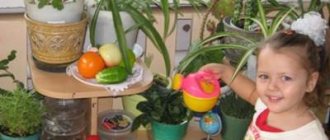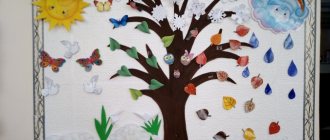What is a sensory room for?
It is well known that a person perceives himself and the world around him through receptors, nerve fibers and parts of the brain that react to light, color, sounds, smells and tactile sensations. Therefore, the combination of different stimuli (for example, light, sound or aromatherapy) makes it possible to have a complex effect on the human senses and achieve tremendous success in the development of children of all age categories. At the same time, the use of different sets of stimuli can have both a tonic/stimulating effect and a calming/relaxing effect.
Depending on the age category, the sensory room in kindergarten can be used:
- at an early age (1-3 years) - for the development of general and fine motor skills, the emotional sphere, tactile sensations, observation and attention, as well as the correction of motor disorders, visual coordination, indicative reactions and the enrichment of passive and active vocabulary;
- in preschool age (3-6 years) - for the development of involuntary and logical thinking, higher mental functions (memory, imagination, attention and perception), the emotional sphere, motivation to learn, cognitive interest, as well as learning relaxation skills, increasing resistance to stressful situations and psycho-emotional relief.
Please note that classes in the sensory room can be conducted both in groups and individually. In the case of group classes, the composition of the group is formed based on the needs and physical/psychological/emotional characteristics of each child. Depending on the needs of each group or individual child, classes are conducted in the following areas:
- psychocorrection of the emotional sphere and behavior - aggression and hot temper, isolation and self-doubt, attention deficit disorder and passivity, fears and hyperactivity;
- neuropsychological correction of “school” problems – lack of educational motivation and cognitive interest;
- developmental activities – development of higher mental functions and emotional sphere, achieving psycho-emotional relief, maintaining/restoring psychological health;
- psychotherapy for a wide range of psychoneurological problems.
How is the learning process organized?
Based on the emotional, physiological or psychological needs of preschool children, classes are divided into two forms: individual and group. From the point of view of psychological and pedagogical impact, the following areas are usually distinguished:
- Neuropsychological correction. It is used most often for children who lack the motivation to remember and assimilate new information, including knowledge of the world around them.
- Correction and psychocorrection of behavior. As practice shows, it is best used for children who experience frequent outbursts of anger, as well as isolation and lack of self-confidence. In addition, such classes show excellent results if it is necessary to remove the baby from a hyperactive or, conversely, passive state. Based on the specific problem, calming or stimulating measures are used. As a result, the child learns to cope with the control of his own emotions, find a common language with others, and also get rid of obsessive states.
- Correction of neurological problems and psychotherapy. Classes of this kind are especially effective when a child stutters, feels fears, and also experiences neuropsychiatric and mental disorders. Such training is usually carried out either individually or in groups of 2-3 children.
- Development classes. Most often used for children aged 1-3 years. They can also be used for older children, especially if they have problems with attention, memory, speech, imagination or imaginative thinking. As a result of this training, children learn to remember various information and also significantly expand their vocabulary.
Speaking about older groups in kindergartens, sensory rooms are often used for them as an effective tool in preparing for school. To do this, children develop skills for independent thinking, resistance to stress, motivation to study and other important aspects.
Presentation “Sensory Corner”
Olga Shugurova
Presentation “Sensory Corner”
The world enters human consciousness only through the door of the external sense organs. If it is closed, then he cannot enter it, cannot enter into communication with it. The world then does not exist for consciousness. B. Preyer
sensory development is the development of his perception and the formation of ideas about the most important properties of objects, their shape, color, size, position in space, as well as smell and taste. The success of a child’s mental, physical, and healthy development largely depends on the level of sensory development , i.e., on how much the child hears, sees, and touches the world around him.
Based on the inevitability of children's sensory development , there is a need to create a sensory corner in each kindergarten group. Its content should be as diverse as possible, aesthetically designed, safe to use and easily applicable in practice. Aesthetics, of course, occupies a very important place when designing a sensory corner , as it is an integral part of sensory education . And special attention should be paid to the practicality and safety of all attributes. I present to your assessment the presentation of our sensory corner . And also photographs of using it in the work process with children.
Attached files:
Presentation “Our wonderful corner of nature” Nature corner of the 2nd junior group The purpose of creating a nature corner in the 2nd junior group is to enrich children’s understanding of diversity.
Presentation “Lapbook “Journey into the world of sensory” Lapbook (lapbook) - literally translated from English means “knee book” (lap - knees, book - book). This is a homemade paper one.
Presentation “Corner on traffic rules” The competition is held with the aim of developing the transport culture of pupils of preschool educational organizations through the involvement of children.
Presentation “We are exploring the world of sensory” Sensory development is the foundation of the child’s overall mental development, which, in turn, is an essential condition.
Developmental subject-spatial environment. Sensory Corner “Magic Shelf” Translated from Latin, “sensorics” means “perception” carried out through the senses. The sensory world is the world of the concrete.
Speech corner in the senior group. Presentation Speech corner in kindergarten In modern preschool education, speech is considered as one of the foundations of raising and teaching children.
Presentation “Mathematics Corner in the middle group” Objectives of the “Entertaining Mathematics Corner”: To promote the development of cognitive interest in mathematics, the organization of training in which.
Presentation “Traffic rules corner in the senior group” In our “Rainbow” group, much attention is paid to the organization of the subject-spatial environment, taking into account the Federal State Educational Standard for Educational Education, which should be built.
Source
Zoning
To ensure training ensures maximum efficiency and comfort, special zones are used, each of which has its own purpose:
- Development and relaxation. This area is equipped with various exercise equipment, tactile paths and panels, transformable houses, floor constructors, toys, puzzles, books, etc. Rugs and mattresses with colorful designs are usually laid on the floor. The lighting in this area should be bright enough.
- Stimulation. Various interactive elements are collected here, the task of which is to show the child’s imagination, as well as emotional and physical activity. These elements are presented in the form of interactive panels, dry pools, business boards, construction sets, aqua panels and others. The learning process in this zone is accompanied by upbeat music and bright lighting.
- Relaxation. Compared to the others, this is the darkest area, which gives it maximum comfort and tranquility. Frameless furniture with a huge number of different elements is usually installed here. These can be water mattresses, bean bags, rugs, lava lamps, projectors, lounge chairs, ottomans, fiber optic panels, scent generators and many others. The soundtrack here is relaxing and measured.
Due to insufficient space, sensory rooms in kindergartens are often made universal. As practice shows, this is not a problem at all, since, as necessary, you can always change the lighting, sound and technical equipment, turning the whole room into a specific zone.
What safety features are needed to use the sensory room?
The main condition for training is safety. Sensory rooms, or rather their contents, should pose absolutely no threat to both the physical and psychological health of children. To do this, the elements must fully comply with all hygiene standards and not be toxic.
We are talking about preschoolers, that is, small children, therefore, there should not be any sharp corners that the child could get hurt on. For this reason, it is best to use frameless furniture with soft fillings. This includes rugs, ottomans, play blocks (transformable houses, floor constructors) and others.
Speaking of small elements, they should all be secured as securely as possible to the main structures, since otherwise kids can easily swallow them with the corresponding consequences.
Without exception, all materials that are present in the sensory room must be made of easily washable materials. Rugs and other fleecy elements must be treated with special compounds. Such products not only remove dirt, but also disinfect the surface, but do not contain chemicals and are completely safe for children. In addition, they should not emit any odors at all, including pleasant ones.
When using children's sensory rooms, special attention should be paid to electrical and electronic devices. Each such device must have maximum resistance to high humidity. All switches and especially sockets are located in such a way that a child cannot reach them.
As you can see, sensory rooms for kindergarten are truly a modern teaching tool, which, if handled correctly and with pedagogical knowledge, can really solve many issues, including quite serious ones.
With the help of sensory rooms, children suffering from psychological, emotional and physical disorders will be able to solve all their problems. Very soon your baby will experience all the joys of learning about the world, and you will experience joy and pride in your son or daughter.
Everything you need to equip a sensory room.
What are the benefits of sensory rooms in kindergartens?
Every child in preschool age is particularly active in learning about the world around him, literally absorbing basic knowledge about it. However, the level of effectiveness depends on how varied and rich the baby’s sensory sensations are. Not only its development, but also its mental, physical and emotional components largely depend on this.
One of the best tools today, with the help of which a child will not only benefit, but also learn about the world around him in the most fun and interesting way possible, is a sensory room. In order for the child not only to open up the world in its entirety, but also to understand the essence of what and how is happening in it, it is enough to work with this tool for only a few hours a week.
What is a sensory room?
Sensory room is a room equipped with stimulants that affect the organs of smell, touch, hearing, vision, etc., and aimed at the development of higher mental functions (speech, memory, thinking, attention, imagination, perception, etc.), emotional sphere and personal qualities of the child. In addition, such stimulants contribute to psycho-emotional relief (relaxation), restoration and maintenance of the psychological health of children.
To equip a sensory room, as a rule, the following equipment is used:
- air bubble columns – actively used for visual stimulation, stimulation of tactile sensations and relaxation;
- interactive touch panels - designed for sound and visual stimulation, development of imagination, creativity and fantasy, as well as for developing cause-and-effect relationships and interactive games;
- optical fiber with side glow - used to attract, maintain and stimulate attention;
- tactile panels – promote the development of imagination
, fine motor skills and physical activity, as well as the activation of physical activity and brain activity; - developmental and rehabilitation elements - aimed at developing physical skills, brain activity, general relaxation, toning muscles and achieving psychological balance of the child;
- decorative elements with lighting effects (suspended ceiling, ceiling modules, wall and floor carpets with fiber optics, light projectors, fluorescent paintings or mini-planetariums) - develop research interest, attract attention, promote the development of visual sensations and general relaxation.
In addition, the equipment of a sensory room almost always includes equipment used for sound and aromatherapy: odor generators, air ionizers and humidifiers, music panels, audio players, sets of CDs with musical works, etc.
Unusual lamps (for example, “Flame”, “Plasma”, “Vulcan” lamps or salt lamps), as well as non-standard upholstered furniture (for example, a ball ottoman, a water mattress or a cube chair) give the sensory rooms a special coziness and atmosphere of comfort. various soft play modules: transformable houses, dry pools with balls, educational tables, play screens, tactile paths, floor constructors and much more. In addition to its main purpose - conducting play activities, developing tactile sensations and physical abilities of children - the soft filling of sensory rooms has massage and relaxing effects, and also guarantees the safety of developmental activities.






